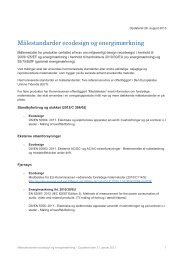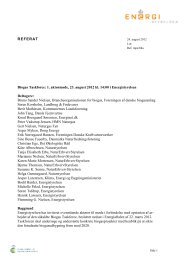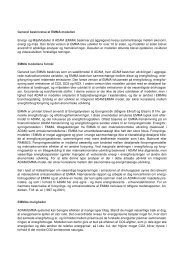Energy Strategy 2050 – from coal, oil and gas
Energy Strategy 2050 – from coal, oil and gas
Energy Strategy 2050 – from coal, oil and gas
Create successful ePaper yourself
Turn your PDF publications into a flip-book with our unique Google optimized e-Paper software.
An important tool to achieve more efficient<br />
buildings <strong>and</strong> businesses is to increase the<br />
energy saving obligations<br />
Most of the funds charged by energy companies to energy<br />
consumers in 2020 to meet the savings obligations<br />
will be used as subsidies for companies <strong>and</strong> households<br />
to buy energy efficient equipment <strong>and</strong> energy consultancy.<br />
The costs of energy saving efforts will therefore to<br />
a large extent be recouped through falling energy consumption<br />
<strong>and</strong> thus lower energy costs for consumers.<br />
Financing renewable energy expansion through<br />
the PSO scheme<br />
Government initiatives to exp<strong>and</strong> renewable energy<br />
up to 2020 include an offshore wind farm at Kriegers<br />
Flak, coastal wind turbines <strong>and</strong> onshore wind turbines,<br />
biomass in electricity <strong>and</strong> heat production, as well as<br />
bio<strong>gas</strong>. These initiatives are financed through the PSO<br />
scheme (Public Service Obligation). The PSO contribution<br />
is a supplement to the price of electricity which,<br />
in addition to exp<strong>and</strong>ing renewable energy, finances<br />
subsidies for small-scale CHP plants, electricity-related<br />
6000<br />
5000<br />
4000<br />
3000<br />
2000<br />
1000<br />
DKK million<br />
0<br />
-1000<br />
research, development <strong>and</strong> demonstration, as well as<br />
other common costs of the electricity system. The PSO<br />
contribution is paid by all electricity consumers through<br />
their electricity bills, although there is an upper limit.<br />
As a new element, a small proportion of the PSO costs<br />
will be covered by <strong>gas</strong> consumers. This will finance the<br />
costs of replacing some of the natural <strong>gas</strong> in the grid<br />
with bio<strong>gas</strong>. Gas consumers are expected to have to<br />
pay DKK 0.2 billion of the total PSO costs in 2020. In<br />
addition to this, some of the expansion of bio<strong>gas</strong> will be<br />
financed through the security of supply tax.<br />
With these government initiatives, PSO costs will gradually<br />
increase up to 2020, when additional PSO costs will<br />
amount to DKK 1.4 billion <strong>and</strong> the total PSO payments<br />
will therefore amount to almost DKK 4.5 billion (2011<br />
prices).<br />
2002 2003 2004 2005 2006 2007 2008 2009 2010 2011 2012 2013 2014 2015 2016 2017 2018 2019 2020<br />
Basis Onshore wind Near-shore turbines Bio<strong>gas</strong> in the <strong>gas</strong> grid Heating settlement Kriegers Flak Bio<strong>gas</strong> changes<br />
Figure 5.2 PSO costs 2002-2020 (2011 prices)<br />
Note: the negative contribution to PSO costs <strong>from</strong> the<br />
new bio<strong>gas</strong> initiatives is because some of the subsidies for<br />
bio<strong>gas</strong> will in future be granted outside the PSO system.<br />
<strong>Energy</strong> <strong>Strategy</strong> <strong>2050</strong> <strong>–</strong> <strong>from</strong> <strong>coal</strong>, <strong>oil</strong> <strong>and</strong> <strong>gas</strong> to green energy.<br />
59

















